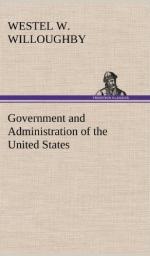_#The Department of Labor.#_—The Department of Labor was created in 1884, as a bureau under the Interior Department. In 1888, it became a separate department. It is a purely statistical bureau. It collects and publishes statistics on the cost of production, on wages, labor statistics, etc. Its six published reports are on (1) Industrial Depressions, (2) Convict Labor, (3) Strikes and Lockouts, (4) Working Women in Large Cities, (5) Marriage and Divorce, and (6) Railroad Employes.
Had all the executive departments been created at one time by a constitutional convention, we should be justified in expecting a greater symmetry and uniformity in the naming and grouping of chief officials. An inspection of the various executive officers shows that not a few are under departments other than would be expected; and the naming of officials is often misleading as to their importance. Within recent years there has appeared a strong tendency to depart yet more from a systematic grouping of executive duties under departments. Executive functions have been given to bodies entirely independent of the departments. To complete our survey of the federal executive we must consider the following: (1) the Interstate Commerce Commission, (2) the Fish Commission, (3) the Civil Service Commission, (4) the Government Printing Office, (5) the National Museum, Smithsonian Institution, the Bureau of Ethnology, (6) the Congressional Library.
_#The Interstate Commerce Commission.#_—With the growth of our railroad system have come various abuses. Roads have discriminated in favor of one shipper over others, and of one locality over others. Combinations have been formed to keep up railroad passenger and freight charges. Their influence has been used in political offices through the issuing of free passenger tickets, etc. Various other minor abuses have centered around these corporations. The States have been powerless to provide a remedy for the roads have been mostly engaged in interstate commerce with which the States are forbidden by the constitution to interfere. To provide a remedy for the principal of these abuses Congress passed the act of February 4, 1887, regulating the practice of railroads and creating the Interstate Commerce Commission to enforce the provisions. The Commission is composed of five commissioners appointed by the President. The Commission sits as a court and adjudicates complaints arising between railroads or between citizens and railroads, involving principles covered by the act. It has rapidly attained its present position as one of the most important courts in the United States. A statistician, attached to the Commission, publishes annual statistics of railroads, covering the extent, the amount, and value of their stock and bonds, expenses of management, receipts, &c. The act, of course, applies only to those railroads lying in more than one State.




